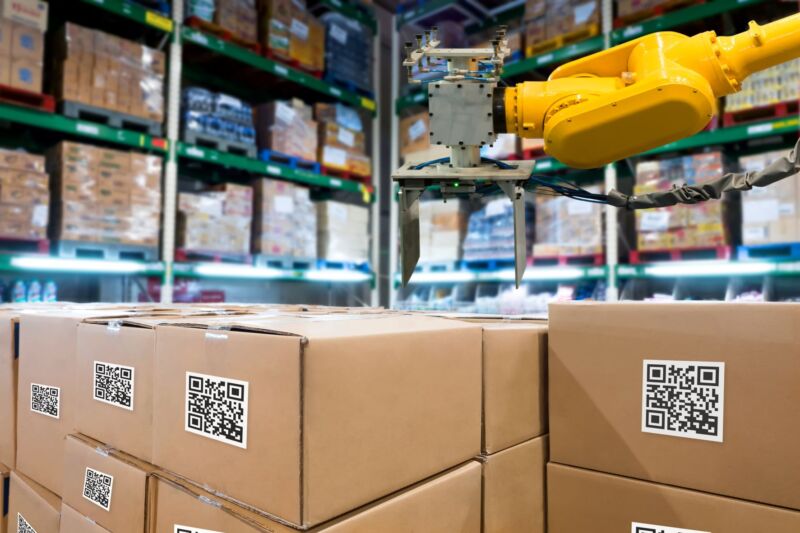The UK has had its fair share of supply chain issues over the past 18 months, from toilet paper panic buying to the dreaded pingdemic. Right now, a shortage of workers seems to be the crux of the issue, to which robotics could provide a solution. Here, Stewart Goulding, managing director at precision drive system supplier EMS, explores how robots could enable an entirely automated supply chain.
From new cars and fuel to Christmas turkeys and pigs in blankets — the only thing the UK doesn’t seem to be low on right now is shortages. In fact, according to a survey by the Office for National Statistics (ONS), around one in six adults were unable to buy essential food between October 20 to 31, 2021.
Most of the supply chain issues the UK has been facing can be attributed to a lack of workers. For example, according to the chief executive of the Food and Drink Federation, the industry is experiencing around half a million staff shortages. While the labour force remains unsettled, there’s high incentive for businesses to invest in automation to fill the gap across the entire supply chain — from production to distribution.
Finessing production
Robots can get to work right from the beginning of the supply chain in manufacturing facilities. According to a report by PwC, British manufacturers are facing the largest shortage of skilled workers since 1989. Automation can help fill the manufacturing industry’s labour gap, with Oxford economics predicting that around 20 million manufacturing jobs will be transferred to robots by 2030.
The type of work where automation is most feasible is typically predictable physical work, such as welding, food preparation and packaging. As much of manufacturing is this type of work, around 59 per cent of production activities could be feasibly automated.
However, while automation has clear benefits inside manufacturing facilities, not all products are produced in factories. Robots are also helping to combat the labour gap on agricultural sites. Due to a shortage of workers, agricultural companies have been reported to have extended their recruitment search to over 6,000 miles in order to find fruit pickers.
Rather than scouring the globe to find suitable labourers, farming businesses can use specially designed robots to fill their worker gap. For instance, fruit picking robots that have been developed with the ability to automatically sense and pick ripe fruit from soil beds using food grade, soft robotic grippers. With machine vision and learning technology, the robots can navigate fields independently and operate for 24 hours a day.
However, fruit picking is not the only agricultural task that can benefit from robotics. Automated animal feeders, area-scanning drones and seed planting field robots are just some of the many robotic systems that can support in agricultural activities traditionally conducted by human workers.
Mastering warehousing
As well as in production, robot workers can be employed further along the supply chain in warehousing. According to the CEO of the UK Warehousing Association, the sector is tens of thousands of workers short. If left unsolved, the labour gap could threaten to hold back the warehousing boom driven by the soaring growth of online shopping during the pandemic.
Fortunately, robots are capable of carrying out all typical warehouse activities, and thus can ensure incoming orders are fulfilled despite the worker shortage. For instance, upon digitally receiving an order, an autonomous mobile robot (AMR) can navigating the warehouse independently using its in-built digital map and a series of barcodes to locate the products desired by the customer.
Once collected, the products can be transported to the packing station. Here, and autonomous packaging machine can use sensors, levers and paddles to pack the order into an appropriate box. Once packaged, the order can be moved onto a conveyor belt or AMR to the dispatch area.
Previously a sticking point in warehouse automation, robots have now been developed to load and unload orders onto lorries ― providing the last link in the automated warehousing chain. However, rather than replace human workers altogether, automation can free up the time and energy of existing workers to focus on other tasks. For example, before warehouse automation, it was normal for warehouse workers to walk over ten miles a day. Now, such activities can be replaced with more meaningful work.
Delivering mighty power
The supply chain industry must work fast to bring enough food and goods to our shelves. Therefore, robots that are employed to help plug the labour gap must be designed with quality, high performance powering systems.
For instance, all FAULHABER motors exhibit an unmatched power to weight ratio, allowing robots in the supply chain to make agile yet forceful movements — whether that’s swiftly picking fruit or carrying a load of heavy orders.
In particular, thanks to its innovative winding technology, the BXT series can deliver torque up to 134 millinewton metres (mNm). Additionally, the multi-pole brushless motors are available in lengths as small as 14 millimetres (mm), making them ideal for robots with small space requirements.
The UK has been struck with shortage after shortage, and with the labour gap still lingering, supply chain managers must turn to automation to meet customer demand. Robots powered by high quality systems can perform with enough power, agility and precision to bring goods through from production to distribution ― helping to make empty shelves a rarity, not normality.




